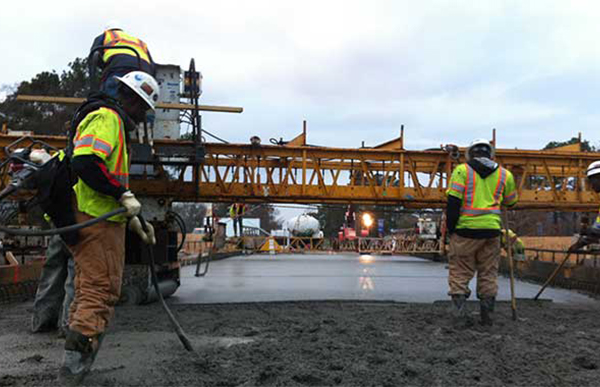RS&H’s 90-Bridge Rehab in North Carolina Reveals Best Practices for DOTs

The North Carolina Department of Transportation (NCDOT) was faced with a mammoth undertaking to rehabilitate and/or replace more than 90 bridges across the division – including structures along and over Interstate 95.
Propelled by Federal Highway Administration (FHWA) funding earmarked for bridge rehabilitation, NCDOT Division 6 turned to RS&H to manage the contracts for each bridge project.
The three-year NCDOT Division 6 residency consisted of multiple projects with a broad scope of work. The bridge rehabilitation and preservation included:
- Multiple bridge replacements with both steel and post-tensioned cored-slab bridges
- Latex modified concrete overlays
- Hydro-demolition on roads, ranging from low-traffic, heavy-haul roads to I-95
- Shotcrete repairs on substructure
- Epoxy bridge deck overlays
- Girder, bearing and superstructure replacements over I-95
- Bridge jacking to repair substructure issues
Our responsibilities included construction oversight, coordinating inspectors, CPM schedule review, ensuring proper sampling and testing, tracking materials records and pre-payment, reviewing and generating monthly and final estimates, holding preconstruction and monthly construction meetings, and HiCAMS data entry. We wrote supplemental agreements, tracked, coordinated, and responded to RFIs, and verified contractor surveys.
Here are just a few lessons we learned from the project that can help other DOTs who face a long list of bridge rehabilitation projects of their own.
Fabrication and Delivery of On-Site Materials
Timing was of the utmost importance to get these bridges reopened for motorists.
Similar, simplified designs on multiple structures allowed the contractors to learn the construction process on the first structure and then repeat the process again and again, speeding up each time they repeated it.
Elastomeric bearing pads were matched in size on each contract to simplify procurement, which also reduced their price due to the quantity being purchased.
Our team opted to pretest and require materials to be delivered to each project site two weeks ahead of operations so there wouldn’t be any construction delays.
Better Demolition Scheduling
In order to alleviate impacts to the public and avoid long road closures, demolition of the old structures wasn’t permitted until shop drawings were complete and beam fabrication was far enough along to give a definitive date of delivery.
This was critical not only to mitigate costs to the contractor, but also to prevent excessive delays and long detours for motorists. By waiting for demolition, the contractor also found use in this time to survey and confirm details of the site.
Ultimately, this practice kept roadways open longer and shortened the gap between demolition and opening to traffic.
Cheaper and Faster is Not Always Better
During design, RS&H assisted in the review of a possible alternative superstructure posed by the contractor to replace a typical deck with a cored-slab accelerated bridge construction.
As we reviewed, it was clear that money and time could be saved with this method. However, the maintenance on the structure would be much more costly – and, ultimately, create more traffic delays – due to low clearances, causing high load impacts.
Surveying is paramount during these accelerated replacements, as calculations are critical to ensure the final deck matches the existing approaches and surrounding geometries where deficiencies may exist. We also had to take into consideration the additional overlay that was placed on adjacent spans. This allowed for an additional half-inch of clearance to the roadway below.
Partnerships are Paramount
One of the biggest aspects of our rehab work on I-95 proved to be closing sections of the interstate at night. Fortunately, we were in lockstep with NCDOT’s Statewide Traffic Operations Center to alert motorists in advance on overhead message boards every day.
We also worked with NCDOT’s Traveler Information Management System, which coordinated with local EMS, police and school systems on needed details surrounding each project.
There was a clear understanding that the interstate must be open by 6 a.m. every day. To get the lanes ready for travel, we opted for very early strength (VES) latex-modified concrete, which would set up and lose its plasticity in 15 minutes. In two hours, the concrete would stand at 4,500 PSI, ready to carry live-load traffic the next morning.
We sampled and tested materials expeditiously so the contractor could place all concrete and have lanes open to traffic in a 2-hour window. Given the timeframe, we could only complete 120 feet of overlay per night.
These partnerships were paramount to the revitalization of these structures throughout NCDOT Division 6.
Learn more about how we can help you revitalize your infrastructure system.


